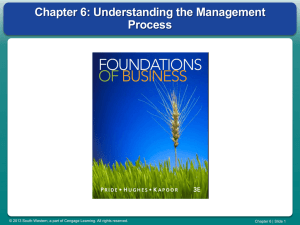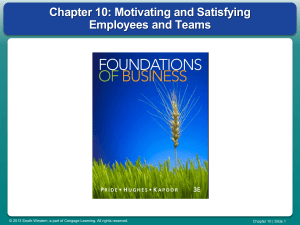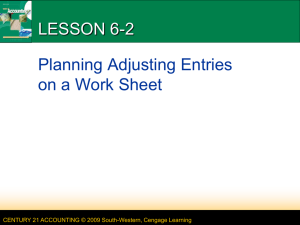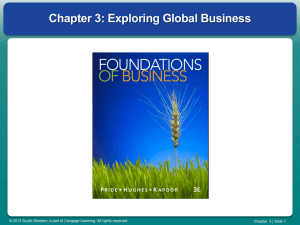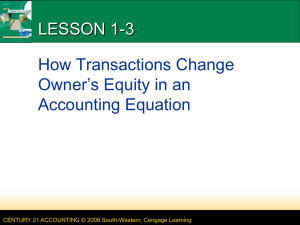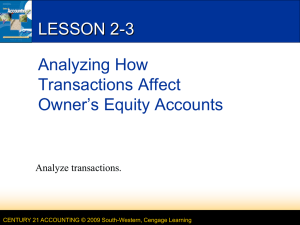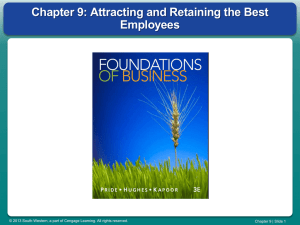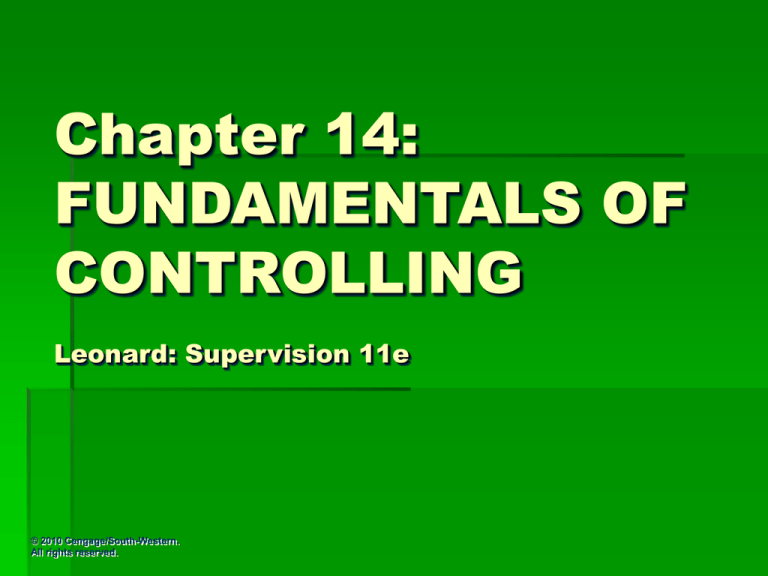
Chapter 14:
FUNDAMENTALS OF
CONTROLLING
Leonard: Supervision 11e
© 2010 Cengage/South-Western.
All rights reserved.
AFTER STUDYING THIS CHAPTER,
YOU WILL BE ABLE TO:
1. Describe the nature and importance of the managerial
controlling function.
2. Identify three types of control mechanisms based on
time.
3. Explain the essential characteristics of effective
controls.
4. Describe the essential steps in the control process.
5. Discuss the supervisor’s role in controlling through
budgets.
© 2010 Cengage/South-Western. All rights reserved.
14–2
AFTER STUDYING THIS CHAPTER,
YOU WILL BE ABLE TO: (cont’d)
6. Discuss the supervisor’s role in maintaining cost
consciousness and in responding to higher-level
managers’ orders to reduce costs.
7. Identify additional control areas and explain how the
controlling function is closely related to the other
managerial functions.
© 2010 Cengage/South-Western. All rights reserved.
14–3
The Supervisor’s Role in Controlling
• Controlling
Is ensuring that actual performance is in line with
intended performance and taking corrective action, if
necessary.
Is essential whenever a supervisor assigns duties to
employees because the supervisor remains
responsible for assigned work.
Is part of the supervisor’s job to keep activities in line
and, when necessary, to get those activities back on
track.
© 2010 Cengage/South-Western. All rights reserved.
14–4
The Supervisor’s Role in Controlling (cont’d)
• Nature of the Controlling Function
One of the five primary managerial
functions.
Most closely related to planning.
Goes on simultaneously with the other
managerial functions.
© 2010 Cengage/South-Western. All rights reserved.
14–5
The Supervisor’s Role in Controlling (cont’d)
• Employee Responses to Controls
Controls are viewed negatively because the amount
of control may determine how much freedom
employees have to do their jobs.
Well designed and properly implemented controls
can positively influence employee motivation and
behavior.
Supervisors should design and apply control
systems that will effectively monitor department
performance and be accepted by employees without
resentment.
© 2010 Cengage/South-Western. All rights reserved.
14–6
The Supervisor’s Role in Controlling (cont’d)
• Controlling Should Be Forward Looking
A supervisor can do nothing about the past.
The main purpose of controlling is not to assign
blame for mistakes but rather to identify deviations
from standards and take prompt corrective action.
• Controlling Should Be Consistent With Strategy
Establishing feedback controls and monitoring
progress enables an organization to know if, how,
and when it has achieved its strategic goals and
objectives.
© 2010 Cengage/South-Western. All rights reserved.
14–7
The Supervisor’s Role in Controlling (cont’d)
• Controlling and Closeness of Supervision
How closely supervisors should monitor an
employee’s work is based on an employee’s
experience, initiative, dependability, and
resourcefulness.
Permitting an employee to work without close
supervision is both a challenge and a test of a
supervisor’s ability to delegate.
By familiarizing themselves with employees’ abilities,
supervisors can learn how much leeway to give and
how closely to follow up and control.
© 2010 Cengage/South-Western. All rights reserved.
14–8
Time Factor Control Mechanisms
• Feedforward Control
Anticipatory action (preventive measures) taken to
ensure that problems do not occur.
• Concurrent Control
Corrective action taken during the production or
delivery process to ensure that standards are being
met.
• Feedback (After-the-Process) Control
Action taken after the activity, product, or service has
been completed.
© 2010 Cengage/South-Western. All rights reserved.
14–9
Characteristics of Effective Controls
Understandable
Flexible
Timely
Effective
Controls
Indicative
© 2010 Cengage/South-Western. All rights reserved.
Suitable and
Economical
14–10
Steps in the Control Process:
Setting Standards
• Standards
Units of measure or criteria against which results are
evaluated.
• Tangible Standards
Standards for performance that are identifiable and
measurable (e.g., quantity and quality of outputs).
• Intangible Standards
Standards for performance results that are difficult to
measure and often relate to human characteristics
(e.g., attitude, morale).
© 2010 Cengage/South-Western. All rights reserved.
14–11
Steps in the Control Process:
Time and Motion Studies
• Motion Study
Is an analysis of work activities to identify ways (i.e.,
best methods) to improve, eliminate, change, or
combine steps to make the job easier and faster.
• Time Study
Is a quantitative technique for analyzing a job to
determine time standards for performing the job.
Select employees for observation
Observe the times needed to accomplish parts of the job
Apply correction factors, and make allowances for fatigue,
personal needs, and unavoidable delays
© 2010 Cengage/South-Western. All rights reserved.
14–12
Steps in the Control Process:
Setting Standards (cont’d)
• Employee Participation
Workers tend to accept standards as reasonable and
fair when they help formulate those standards.
Workers resent imposed standards that appear
designed solely to increase worker output.
© 2010 Cengage/South-Western. All rights reserved.
14–13
Steps in the Control Process:
Setting Standards (cont’d)
• Strategic Control Points (Strategic Standards)
Supervisors should choose performance criteria for
assessment that are key indicators of overall
performance.
A supervisor should be careful to choose strategic
control points that do not significantly impede other
important standards.
By closely watching trends and changes in these
indicators, the supervisor should be able to spot
problems requiring corrective action.
© 2010 Cengage/South-Western. All rights reserved.
14–14
Steps in the Control Process:
Setting Standards (cont’d)
• Examples of Strategic Control Points:
Number of employees’ voluntary resignations and
requests for transfer
Levels of absenteeism, tardiness, and turnover
Accident frequency and severity rates
Number and types of employee grievances and
complaints
Number and types of customer complaints
Amount of scrap and rejects and unexplained losses
of materials and inventory
© 2010 Cengage/South-Western. All rights reserved.
14–15
Checking Performance against Standards
Personal
Observation
Oral and Written
Reports
Spot
Checks
Sampling
Techniques
© 2010 Cengage/South-Western. All rights reserved.
14–16
Checking Performance against Standards
(cont’d)
• Exception Principle
Concept that supervisors should concentrate their
investigations on activities that deviate substantially
from standards.
• Sampling
The technique of evaluating some number of items
from a larger group to determine whether the group
meets acceptable quality standards.
Statistical quality control (SQC): a method to determine not
only which items or services to inspect but also how many to
inspect.
© 2010 Cengage/South-Western. All rights reserved.
14–17
Taking Corrective Action
• Deviations from standards occur because:
Standards were based on faulty forecasts or
assumptions
Unforeseen problems arose and distorted results
Failure occurred in some preceding job or activity
The employee who performed the job was unqualified
or was given inadequate directions or instructions
The employee who performed the job was negligent
or failed to follow directions or procedures
© 2010 Cengage/South-Western. All rights reserved.
14–18
Taking Corrective Action (cont’d)
• Before taking corrective action, the
supervisor should:
Determine the causes of the deviation by
analyzing the situation:
Standards?
Employees?
Decide which remedial actions will obtain
better results.
© 2010 Cengage/South-Western. All rights reserved.
14–19
Budgetary Controls
• Budget
A financial plan that projects expected revenues and
expenditures during a set period.
• Budgetary Control
The use of budgets by supervisors, accountants, and
higher-level managers to control operations so that
they comply with organizational standards for making
budgets.
• Operating Budget
The assignment of dollar allocations to the costs and
expenses needed to run the business, based on
expected revenues.
© 2010 Cengage/South-Western. All rights reserved.
14–20
Budgetary Controls (cont’d)
• Supervisory Participation in Budget Making
Incremental budgeting
A technique for projecting revenues and expenses based on
history.
Zero-base budgeting
The process of assessing, on a benefit-and-cost basis, all
activities to justify their existence.
Departmental expense budget
A budget that covers the expenditures incurred by the
department.
© 2010 Cengage/South-Western. All rights reserved.
14–21
Budgetary Controls (cont’d)
• Supervising within the Budget
Supervisors must manage their departments within
budget limits and refer to their budgets to monitor
their expenditures during the operating period.
If the expenditures for an item greatly exceed the
item’s budgeted amount, the supervisor must find out
what happened.
A supervisor’s budget should not be so detailed and
rigidly applied that it becomes a burden.
© 2010 Cengage/South-Western. All rights reserved.
14–22
Cost Control and the Supervisor
Sharing Information and
Responsibility with
Employees
Maintaining Cost
Awareness
Controlling
Costs
Responding to a CostCutting Order
© 2010 Cengage/South-Western. All rights reserved.
14–23
Other Control Areas: Specialized Controls
• Inventory Control
Is keeping watch over raw materials, supplies, work-
in-process, finished goods, and the like.
Is maintaining sufficient, though not excessive,
inventory; keeping status records of all inventory;
ordering economic lot sizes; and many other tasks.
• Quality Control
Is maintaining the quality standards a firm sets for its
products or services by monitoring and continual
improvement to ensure that quality is maintained.
© 2010 Cengage/South-Western. All rights reserved.
14–24
Other Control Areas: Specialized Controls
(cont’d)
• Production Control
Consists of a number of activities that are designed to
keep overall operations on schedule.
Involves routing operations, scheduling, and, when
necessary, expediting work flow.
Gantt charts
– A diagram or pictorial representation of the progress and status
of various jobs in production.
Computerized network analyses
– Program evaluation review technique (PERT)
– Critical path method (CPM)
© 2010 Cengage/South-Western. All rights reserved.
14–25
Controlling and the Other
Managerial Functions
Planning
Leading
Controlling
Organizing
Staffing
© 2010 Cengage/South-Western. All rights reserved.
14–26
KEY TERMS
• Budget
• Operating budget
• Concurrent control
• Sampling
• Controlling
• Standards
• Exception principle
• Feedback control
• Strategic control points
(strategic standards )
• Feedforward control
• Tangible standards
• Incremental budgeting
• Time study
• Intangible standards
• Zero-base budgeting
• Managerial controlling
• Motion study
© 2010 Cengage/South-Western. All rights reserved.
14–27

